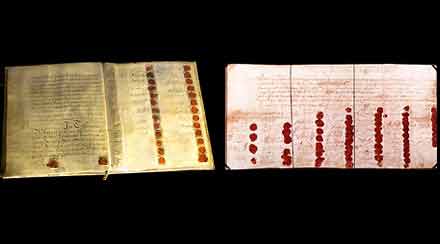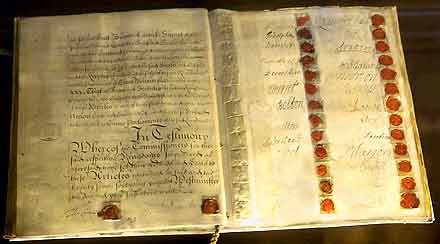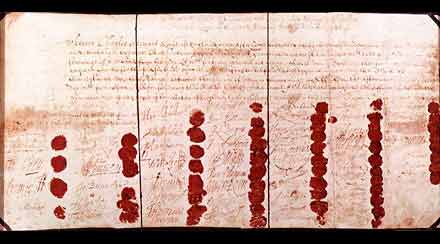Historical Documents
© 2007
Armchair Travel Co. Ltd. - This page may be used for non-commercial purposes
ONLY!
![]()

[ Play
Narrated and Animated Movie ! ] Within this cabinet are stored some extremely important documents concerning British Parliamentary History.
On the 22nd of July 1706 the Parliamentary commissioners of Scotland and England met and agreed to a treaty between their two countries. It is this document here which formed the treaty between the two countries, and is named 'The Articles of Union'.
In the early part of 1707 both parliaments passed acts to preserve the 'True Protestant Religion' as established in their representative countries - these were safeguards which were incorporated into the Acts ratifying the Articles of Union. This official Union of England and Scotland came into full effect on May 1st 1707, and merged both the countries and their parliaments under the name of Great Britain.
This is the death warrant of Charles I. In 1648 after many vicious battles had been fought in the English Civil War, it was decided that the King, Charles I, should be put on trial for treason, as the cause of all the bloodshed. In January 1649, Charles was brought before the high court of justice in Westminster Hall. Within seven days the court had convicted him of treason - as a tyrant, traitor and murderer, sentencing him, by this act, to death by public execution. On January 30th 1649, Charles was executed outside the banqueting Hall of Whitehall.
Since the accession of James VI of Scotland and I of England the fortunes of England and Scotland and their crowns had become inextricably linked with James' Stuart successors sitting on both these thrones and that of Ireland as well. After William of Orange was invited to take the crown in 1688, his war with France (starting the following year and continuing until 1797) emphasised the necessity of integrating England's and Scotland's interests more closely, particulary in view of Scotland's long history of association with France against England.
After William's death in 1702, the war with France continued during the reign of his wife's sister Anne. Although the great general Marlborough won a succession of important victories, the logic of a closer union between England and Scotland became impelling both for strategic and economic reasons. Although the Scottish Parliament had been minded to break the connection altogether, the English offered sufficient inducements to the Scottish parliamentarians and concessions to their national interests to induce the Scots to sign the Act of Union in 1707.
By the Act, the Scottish Parliament was incorporated into the English with 16 peers and 45 commoners representing Scotland. Scotland gained the benefits of free trade with England and its colonies and a financial grant of the equivalent of its share of the English National Debt that it would from thenceforward assume. Its church and legal system were also safeguarded. After Queen Anne's death in 1714 when the Jacobites missed their best opportunity to reverse the process, both sides generally made the best of the situation with the main exception of the rebellion in 1745. Now, almost 300 years later, it seems probable that a Scottish Parliament will again sit in Edinburgh.
On the 6th of January 1649 the House of Commons passed an Act appointing one hundred and thirty five commissioners to be a High Court of Justice to try King Charles I. In spite of many defections and of doubts about procedure, the court met formally for the first time on the 20th January in Westminster Hall and by the 26th, after hearing depositions from thirty three witnesses, the commissioners had agreed amongst themselves to condemn the king to death. On Saturday the 27th their sentence was pronounced in open court.
By then the death warrant had already been drawn up, with blanks for the time and place of the execution, which a committee was left to arrange. Some signatures - perhaps the first twenty eight - may well have been collected at that stage. Nothing could be done on the Sunday but, once the details of the execution had been approved on Monday the 29th, the blanks were filled in and the warrant was taken into the Painted Chamber where the remaining signatures were added. Ultimately, fifty nine of the sixty seven commissioners who had pronounced judgement signed the warrant.
The story that Cromwell had to browbeat some of the commissioners into signing is unproven, but certainly there had been a delay in settling the arrangements which the warrant had not allowed for. It therefore became necessary to erase the dates and replace them with 'XXIXth' January and 'uppon Saturday last'. Presumably also two of the original army officers to whom the warrant was addressed had refused to serve and the names of Hacker and Phayre were substituted. Other alterations may represent corrections to scribal errors though it was not clear Gregory Clement wrote his name over an erasure or whether his name was (incompletely) erased in 1652 because of his scandalous behaviour.
On the 30th January Charles I went to execution on a scaffold erected outside the Banqueting Hall in Whitehall. The death Warrant remained in Colonel Hacker's possession until the restoration of Charles II in 1660 when Hacker, then a prisoner in the Tower of London, was ordered by the House of Lords to surrender the warrant to them. Since then the document has remained in their custody, at first in the Jewel Tower at Westminster, from 1851 on display in the House of Lords Library, and from 1979 in the Royal Gallery. Over the centuries it became worn and faded and even in 1800 it was 'not in a perfect state of preservation', but it is still fully legible under ultra-violet light. Unfortunately, even with the aid of a digital scanner, it is not possible to recover the words erased in 1649. On the back of the warrant is written in a seventeenth-century hand: 'The bloody Warr[an]t for murthering the King'.
The document is on a piece of parchment which measures 43.8 cm x 21 cm. All the seals are of red wax, some of which are broken or obscured.
[ Virtual
Tour ] [ Main Topics
Index ]


Additional Information on
Historical Documents
The Death Warrant of Charles I, 1649
Explore-Parliament.net: Advanced Category Search
Keyword Categories:
_Object_Document
_Event_Historical
_Topic_Charles_I_
_Documents